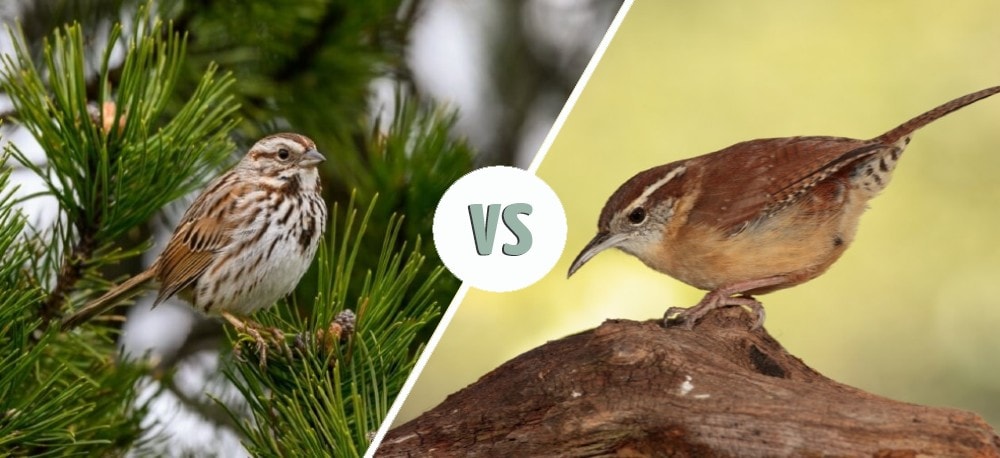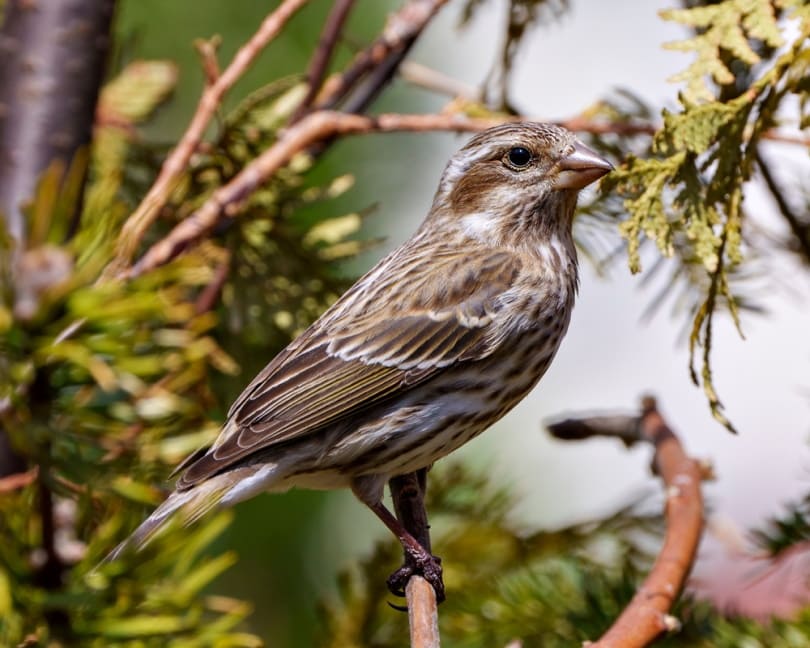Sparrow vs. Wren: How to Tell the Difference
Last Updated on

Both sparrows and wrens can often be seen hopping around urban and suburban yards, and visiting the neighborhood bird feeding stations in large numbers. It’s easy to misidentify wrens as sparrows because the two birds are so similar.In fact, birdwatchers refer to both sparrows and wrens as Little Brown Birds (LBB) or Little Brown Jobs (LBJ), because they are notoriously difficult to distinguish. But there are ways to tell them apart, once you know what to look for!
In this article, we’ll talk you through all their subtle differences, so next time you see a LBB bouncing around in your yard, you’ll know for sure if it’s a sparrow, a wren, or something else altogether!

Visual Differences

At a Glance
- Average Length: 5–7 inches
- Average Weight: 0.9–1.1 ounces
- Wingspan: 7.5–9.8 inches
- Tail Length: 2–2.6 inches
- Average Lifespan: 4–5 years
- Average Weight: 0.3–0.4 ounces
- Wingspan: 5.9 inches
- Tail Length: 1.5–2 inches
- Average Lifespan: 2 years

Sparrow Overview
These incredibly resourceful birds have managed to populate almost the entire world. They love feeding off scraps of food that we throw away, or better yet, the food we provide for them in bird feeders. Sparrows don’t fear humans, as some birds might. These little city-dwellers are loud and confident, and you can easily spot them in their family groups in spring and summer.

Characteristics & Appearance
While male and female sparrows do differ slightly, they have some defining features that are easy to spot once you know what to look for. On average, sparrows measure between 5 to 7 inches in length. Both male and female sparrows have a short, stout, and conical bill, which they use to crack seeds.
Male Sparrows
The colors of the male sparrow’s plumage are often more vivid than the female sparrow. Male sparrows have a black throat (or bib), white cheeks, gray crown, and chestnut-colored neck. Their bellies are usually lighter in color, and their wings are a stripy mix of black, tan, and brown.
Female Sparrows
The colors of the female sparrow are a little duller—this makes them great at camouflaging. Female sparrows are buff and light brown all over, though their wings are marked with dark brown and buff stripes. Female sparrows also have a white line that stretches away from their eyes, almost like eyebrows.
Habitat
Sparrows are masters at adapting to new habitats. These birds can be found almost all over the world. They’ve colonized nearly every continent, including Africa, Australasia, Europe, North America, and South America.
Sparrows like to live near humans because they’re able to get food easily, so they’re often found in city parks and yards. Farms are another favorite habitat for sparrows.

Nesting
You may have already guessed that these little birds are opportunists when it comes to sourcing food, but what about shelter? Although sparrows can and do make their own nests, they’re also quite happy to squat and take over other birds’ nests! Sparrows have been known to steal nests from bluebirds and purple martins.

Wren Overview
Wrens are tiny brown birds, often mistaken for sparrows. They’re round, plump, and sing louder than you’d expect for a bird their size.
Altogether, there are 88 species of wren, but only the Eurasian wren can be found outside the Americas. The rest occupy a vast array of habitats, from the cold woodlands of Alaska, all the way to Argentina and the Neotropics.

Characteristics & Appearance
The different species of wren have slightly different characteristics when it comes to appearance, but most of them are round and small, with a short tail that they often hold upright. They’re brown all over, ranging from light brown to warm brown, depending on the species. All wrens have a thin, delicate, and long bill.
Winter Wren
The winter wren can be found in coniferous forests from British Columbia to the Atlantic Ocean. These birds have a white throat, and they’re tan all over. The winter wren is the smallest of the species, yet its song can be up to ten times louder than a rooster!

Cactus Wren
These wrens inhabit arid lands, and can be found in the southeast of the United States, as well as in Mexico. Cactus wrens have a distinctive white eyebrow that streaks over each eye, and their plumage is barred in black and white. They’re called cactus wrens because they often build their nests and seek refuge from predators in cactus plants.
Brown-throated Wren
The brown-throated wrens inhabit the woodlands in the highlands of Mexico. They have a distinctive buff eyebrow marking, and they are a warm brown color all over. Brown-throated wrens are around the same size as house wrens—between 4 to 5 inches in length.
Rock Wren
Rock wrens like to live in rock crevices. These birds are so intent on their habitat that they sometimes use small stones to build sidewalks leading to their nests. The rock wrens are slightly larger than brown-throated and house wrens, and they are light buff and tan in color.


What Are the Differences Between Sparrows and Wrens?
Now that you have an overview of what sparrows and wrens look like, let’s take a closer look at their specific identifiable features, and how they differ from one another.
- Size: The first thing to look for when deciding if a bird is a wren or a sparrow is its size. Sparrows are larger than wrens, whereas wrens are very small birds.
- Bill: Sparrows and wrens have very different bills. While sparrows have a short, stout, conical bill, wrens have bills that are long, slender, and delicate.
- Plumage: While male sparrows have very distinct and vivid coloring, female sparrows tend to be very similar in color to wrens. It always helps to remember that sparrows have stripes of brown, white, and buff on their wings, whereas wrens have brown wings which are barred with black.
- Tail: Both sparrows and wrens have short tails, but compared to a wren, sparrows’ tails are longer and broader. Wrens sometimes cock their tails to face up—this is a great identifying feature.
- Legs: When identifying birds, you may not think to look at their leg. But when it comes to wrens and sparrows, the legs can be a great giveaway. While sparrows have short legs, wrens have relatively long, spindly legs in comparison with their round, small bodies.

Final Thoughts
Sparrows and wrens are both incredibly common LBBs or Little Brown Birds, and although they can be mistaken for one another, they do have identifiable features. The quickest way to tell a wren from a sparrow is to check their bills and their legs. Wrens have long and thin bills, while sparrows have short and stubby bills. Wrens have long and thin legs, while sparrows have shorter legs.
Now that you know how to tell them apart, you can enjoy watching the birds in your yard, and know exactly which ones are which!
Featured Image Credit: (L) FotoRequest, Shutterstock | (R) Raul Baena, Shutterstock
About the Author Cheryl Regan
Cheryl is a freelance content and copywriter from the United Kingdom. Her interests include hiking and amateur astronomy but focuses her writing on gardening and photography. If she isn't writing she can be found curled up with a coffee and her pet cat.
Related Articles:
How to Clean a Refractor Telescope: Step-by-Step Guide
How to Clean a Telescope Eyepiece: Step-by-Step Guide
How to Clean a Rifle Scope: 8 Expert Tips
Monocular vs Telescope: Differences Explained (With Pictures)
What Is a Monocular Used For? 8 Common Functions
How to Clean a Telescope Mirror: 8 Expert Tips
Brightfield vs Phase Contrast Microscopy: The Differences Explained
SkyCamHD Drone Review: Pros, Cons, FAQ, & Verdict
